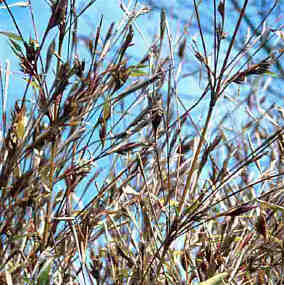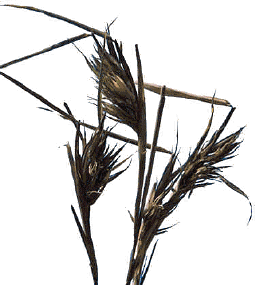|
  The
very
popular belief that bamboos all flower together throughout the world is rarely true. When a bamboo flowers profusely, the
plant is weakened and, if the flowering bout is repeated for a number of
years, this can lead to the plant dying. Profuse flowering
usually causes a bamboo to look unsightly and many gardeners dig them
out, but given time a bamboo will recover its former stature. Partial
flowering, where only one or a few culms bear flowers, seldom causes the
plant any lasting harm. Gregarious flowering normally occurs when a
single clone has been repeatedly divided and distributed, and
every
plant of that clone flowers at about the same time. The
very
popular belief that bamboos all flower together throughout the world is rarely true. When a bamboo flowers profusely, the
plant is weakened and, if the flowering bout is repeated for a number of
years, this can lead to the plant dying. Profuse flowering
usually causes a bamboo to look unsightly and many gardeners dig them
out, but given time a bamboo will recover its former stature. Partial
flowering, where only one or a few culms bear flowers, seldom causes the
plant any lasting harm. Gregarious flowering normally occurs when a
single clone has been repeatedly divided and distributed, and
every
plant of that clone flowers at about the same time.
Unfortunately, my stock of Fargesia murieliae have flowered so
strongly over recent years that most of them have died. Only one remains
but looks very unhealthy, as the photo shows. On the positive side some
young seedlings have resulted from this event to provide new stock. The
excitement is to know if one of them has special characteristics, or
even if I have achieved that very unlikely new clone. (Bamboo is wind
pollinated and if other clones are nearby there is a small chance of a
completely new clone arising). However, it will be some years before
this becomes clear. If you doubt that seedlings vary much, just visit
your nursery and look at a dozen F. murieliae. Some obvious variation in form,
colour and tendency to leaf curl in the sun is likely. What
can be done when a bamboo flowers? Most keen gardeners and bamboo
enthusiasts will surely do everything possible to rescue a favoured
plant. My recent experience with Fargesia murieliae was not a happy one.
Flowering culms were removed but new growth flowered vigorously. They
were kept well fed and watered but to no avail. Regrettably I did not
take vegetative cuttings, which I am told often provides a proportion of
survivors. Next time ...... |